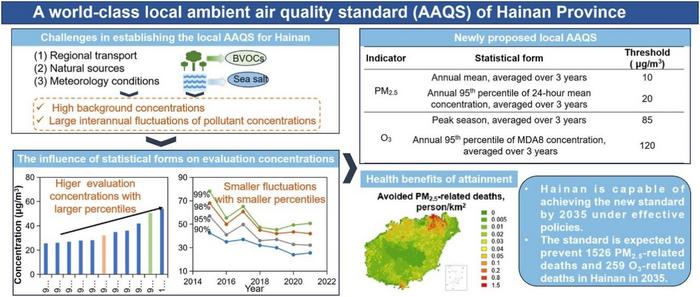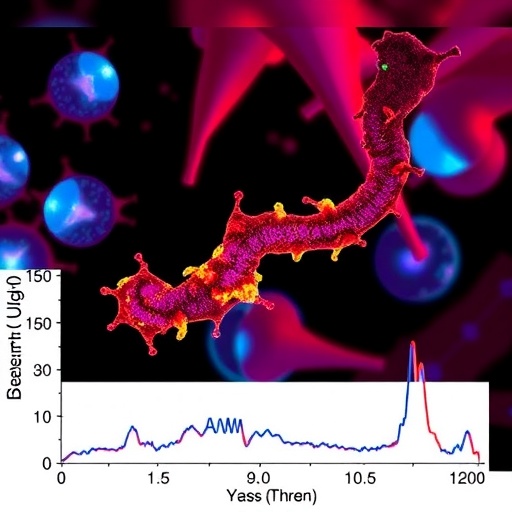Air pollution significantly impacts human health, with Hainan Province in China aiming to achieve world-leading ambient air quality by 2035, despite already having relatively good air quality in China. The existing Ambient Air Quality Standards (AAQS) offer insufficient guidance for further enhancing air quality in Hainan, which stands at the forefront of China’s environmental protection efforts. Consequently, it is imperative to develop Hainan’s local AAQS. This initiative, responding to WHO’s strengthened guidelines, aims to address unique regional challenges in air quality assessment, like high background pollutant levels and other complex environmental factors. The development of these tailored standards is crucial for further improving air quality and health outcomes in Hainan and can serve as a model for other regions seeking to surpass national benchmarks and achieve global air quality leadership.
In a landmark study published in Eco-Environment & Health on 28 October 2023, a team from Tsinghua University and several other Chinese institutions presents a comprehensive approach to developing local AAQS tailored for Hainan Province, China. This initiative is part of Hainan’s broader effort to enhance its ecological environment and achieve world-class air quality by 2035.
The study began by looking at air quality standards from different countries and regions, focusing on how they measure and limit pollution. For Hainan, the researchers suggested new, realistic goals for reducing common pollutants, considering health effects over both short and long periods. They used these goals, along with local data and international guidelines, to create Hainan’s own standards.
To predict if Hainan can meet these goals, the researchers used a computer program called the Community Multiscale Air Quality (CMAQ) model. This program helped them see how the air quality might change by 2035 with different ways of controlling pollution. They found that with strong policies, Hainan could indeed meet these new, stricter air quality goals by 2035.
Lead researcher Bin Zhao from Tsinghua University emphasizes, “Developing local AAQS is critical for regions like Hainan, where the standard needs to reflect local conditions while aiming for global leadership in air quality. Our research is a step towards achieving that delicate balance.”
The pioneering work of establishing local AAQS in Hainan Province represents a significant step towards a healthier environment and serves as a model for regions worldwide. As the province moves towards implementing these standards, it embarks on a path to achieving world-leading air quality by 2035.
The study estimates that adhering to the new standards could prevent thousands of premature deaths annually by 2035 due to reduced long-term exposure to PM2.5 and O3. This proactive approach not only promises a healthier future for Hainan’s residents but also sets a precedent for other regions to develop their own localized air quality standards.

Credit: Eco-Environment & Health
Air pollution significantly impacts human health, with Hainan Province in China aiming to achieve world-leading ambient air quality by 2035, despite already having relatively good air quality in China. The existing Ambient Air Quality Standards (AAQS) offer insufficient guidance for further enhancing air quality in Hainan, which stands at the forefront of China’s environmental protection efforts. Consequently, it is imperative to develop Hainan’s local AAQS. This initiative, responding to WHO’s strengthened guidelines, aims to address unique regional challenges in air quality assessment, like high background pollutant levels and other complex environmental factors. The development of these tailored standards is crucial for further improving air quality and health outcomes in Hainan and can serve as a model for other regions seeking to surpass national benchmarks and achieve global air quality leadership.
In a landmark study published in Eco-Environment & Health on 28 October 2023, a team from Tsinghua University and several other Chinese institutions presents a comprehensive approach to developing local AAQS tailored for Hainan Province, China. This initiative is part of Hainan’s broader effort to enhance its ecological environment and achieve world-class air quality by 2035.
The study began by looking at air quality standards from different countries and regions, focusing on how they measure and limit pollution. For Hainan, the researchers suggested new, realistic goals for reducing common pollutants, considering health effects over both short and long periods. They used these goals, along with local data and international guidelines, to create Hainan’s own standards.
To predict if Hainan can meet these goals, the researchers used a computer program called the Community Multiscale Air Quality (CMAQ) model. This program helped them see how the air quality might change by 2035 with different ways of controlling pollution. They found that with strong policies, Hainan could indeed meet these new, stricter air quality goals by 2035.
Lead researcher Bin Zhao from Tsinghua University emphasizes, “Developing local AAQS is critical for regions like Hainan, where the standard needs to reflect local conditions while aiming for global leadership in air quality. Our research is a step towards achieving that delicate balance.”
The pioneering work of establishing local AAQS in Hainan Province represents a significant step towards a healthier environment and serves as a model for regions worldwide. As the province moves towards implementing these standards, it embarks on a path to achieving world-leading air quality by 2035.
The study estimates that adhering to the new standards could prevent thousands of premature deaths annually by 2035 due to reduced long-term exposure to PM2.5 and O3. This proactive approach not only promises a healthier future for Hainan’s residents but also sets a precedent for other regions to develop their own localized air quality standards.
###
References
DOI
10.1016/j.eehl.2023.10.002
Original Source URL
https://doi.org/10.1016/j.eehl.2023.10.002
Funding information
The National Key R&D Program of China (2022YFC3700702); The Energy Foundation, and the Tsinghua-Toyota Joint Research Institute Inter-disciplinary Program.
About Eco-Environment & Health
Eco-Environment & Health (EEH) is an international and multidisciplinary peer-reviewed journal designed for publications on the frontiers of the ecology, environment and health as well as their related disciplines. EEH focuses on the concept of “One Health” to promote green and sustainable development, dealing with the interactions among ecology, environment and health, and the underlying mechanisms and interventions. Our mission is to be one of the most important flagship journals in the field of environmental health.
Journal
Eco-Environment & Health
DOI
10.1016/j.eehl.2023.10.002
Subject of Research
Not applicable
Article Title
The development of local ambient air quality standards: A case study of Hainan Province, China
Article Publication Date
11-Dec-2023
COI Statement
The authors declare that they have no competing interests




